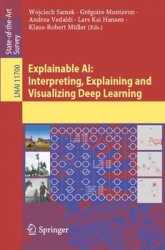 Название: Explainable AI: Interpreting, Explaining and Visualizing Deep Learning
Название: Explainable AI: Interpreting, Explaining and Visualizing Deep Learning Автор: Wojciech Samek, Gregoire Montavon, Andrea Vedaldi
Издательство: Springer
Серия: Lecture Notes in Computer Science
Год: 2019
Страниц: 435
Язык: английский
Формат: pdf (true)
Размер: 51.8 MB
Разработка «интеллектуальных» систем, которые могут принимать решения и работать автономно, может привести к более быстрым и последовательным решениям. Ограничивающим фактором для более широкого внедрения технологии искусственного интеллекта (ИИ) являются риски, связанные с отказом от контроля и надзора со стороны человека за «интеллектуальными» машинами. Для чувствительных задач, связанных с критически важной инфраструктурой и влияющих на благосостояние или здоровье человека, крайне важно ограничить возможность неправильных, ненадежных и небезопасных решений и действий.
The development of “intelligent” systems that can take decisions and perform autonomously might lead to faster and more consistent decisions. A limiting factor for a broader adoption of Artificial Intelligence (AI) technology is the inherent risks that come with giving up human control and oversight to “intelligent” machines. For sensitive tasks involving critical infrastructures and affecting human well-being or health, it is crucial to limit the possibility of improper, non-robust and unsafe decisions and actions.
Before deploying an AI system, we see a strong need to validate its behavior, and thus establish guarantees that it will continue to perform as expected when deployed in a real-world environment. In pursuit of that objective, ways for humans to verify the agreement between the AI decision structure and their own ground-truth knowledge have been explored. Explainable AI (XAI) has developed as a subfield of AI, focused on exposing complex AI models to humans in a systematic and interpretable manner.
The 22 chapters included in this book provide a timely snapshot of algorithms, theory, and applications of interpretable and explainable AI and AI techniques that have been proposed recently reflecting the current discourse in this field and providing directions of future development.
The book is organized in six parts:
1: Towards AI Transparency
2: Methods for Interpreting AI Systems
3: Explaining the Decisions of AI Systems
4: Evaluating Interpretability and Explanations
5: Applications of Explainable AI
6: Software for Explainable AI
Скачать Explainable AI: Interpreting, Explaining and Visualizing Deep Learning